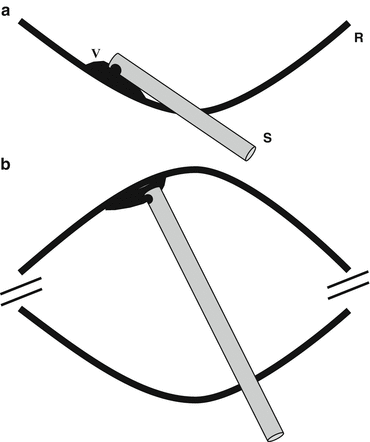(1)
St. Johns, FL, USA
(2)
Helen Keller Foundation for Research and Education, International Society of Ocular Trauma, Birmingham, AL, USA
(3)
Consultant and Vitreoretinal Surgeon, Milos Eye Hospital, Belgrade, Serbia
(4)
Consultant and Vitreoretinal Surgeon, Zagórskiego Eye Hospital, Cracow, Poland
24.1 Removal of the Vitreous
The basic movements the surgeon makes with the probe are the following:
Forward/backward (push deeper or withdraw along the same axis): closer to the posterior pole or to the sclerotomy.
Around, 360° in the vitreous cavity, with the pivot point being at the sclerotomy site (see Fig. 20.3).
Rotation, 360° around the axis of the probe’s shaft.
A combination of the 3. This is by far the most common occurrence.
While the positioning of the probe is done in a “semiconscious” way by the surgeon,1 there are some caveats to remember, which help to reduce the risk of iatrogenic damage ththe probe may otherwise cause:
The probe is not simply a port; its shaft must also be taken into account when maneuvering in the vitreous cavity. By concentrating only on the port (since this is the active [“useful”] part of the probe) the surgeon can easily forget that the shaft is also there, increasing the risk of “lens touch” during anterior PPV (see Sect. 25.2.3.1).
The angle between the probe and the retina changes according to where the probe is.2
The shaft is truly perpendicular to the retinal surface in certain areas on the opposite side of the disc,3 although scleral indentation can also create the 90° angle (see below and Sect. 28.2). In the posterior pole the angle closely approximates being perpendicular. At all other locations, the angle is an acute one.
The shaft is parallel with the retina in the vicinity of the scleral insertion.
The relation of the port’s plane4 to the retina varies with the shaft’s angle, which in turn determines how vitreous or membranes are separated from the retina.
Get Clinical Tree app for offline access
If the shaft is held at or close to a right angle with the retina,5 the port cannot be turned so that it directly faces the retina.6 If the probe is moved along (parallel to) the concave retinal surface, it is able to separate/cut/remove proliferative membranes safely (see below).7
Even in the posterior pole, however, this ideal situation is true in only a small area. The angle outside this relatively small circle starts to change, more rapidly on the side where the probe is (i.e., a nasally inserted probe maintains the close-to-right angle in a larger area temporally than nasally).
The smaller the shaft’s is angle to the retina, the higher the risk that the rotation of the port toward the retina can result in iatrogenic injury: the probe can “bite” into the retina even if the vacuum/flow is very low and the duty cycle high. The implication when working in the periphery is an increased risk in the vicinity of probe insertion compared to that on the opposite side (see Fig. 24.1) – hence the suggestion to switch hands in the pseudophakic eye to complete the vitreous removal at the base.

Fig. 24.1
The angle of the probe’s shaft and the risk of retinal injury. (a) When the shaft (S) is held (close to) parallel to the retina (R), such as the case in the vicinity of the probe’s insertion site, the port can be turned so that it faces the retina, increasing the risk of biting into it, rather than simply removing the vitreous (V) from the surface. (b) On the opposite side of the eyeball, the angle of the shaft is (close to) perpendicular to the retina. The port’s plane makes it impossible to directly injure the retina (although injury is obviously possible if the retina is dragged into the port by the adherent vitreous). (This, however, completely changes if the sclera is indented; see Fig. 28.1.) In the posterior pole (not shown here) the angle is close enough to the perpendicular to mimic this scenario, allowing retina-parallel membranes to be cut by the probe if certain conditions are also met (see the text for more details)
Stay updated, free articles. Join our Telegram channel

Full access? Get Clinical Tree


